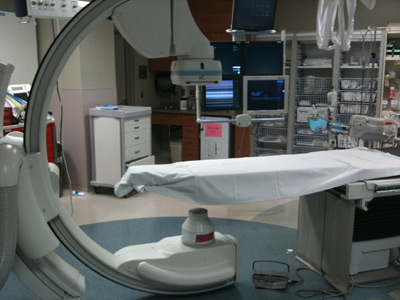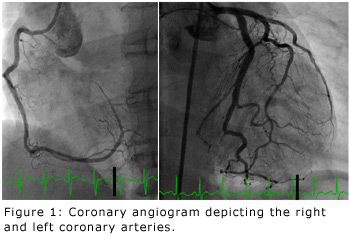
A
cardiac catheterization, also known
as a coronary angiogram or heart cath, is a procedure performed to evaluate for abnormalities or blockages in the
arteries that supply blood to the heart (coronary arteries).
BCS Heart provides services of
cardiac catheterization to those patients who may benefit.
The procedure is commonly performed in patients who have
symptoms of coronary artery disease (termed angina), patients who are actively having a heart attack, and patients who
are planning to undergo a heart surgery for reasons unrelated to coronary artery disease (e.g. valvular disease).
The image to the top right is that of a typical cardiac catheterization laboratory. There is a table for the patient, a
C-shaped X-ray camera, and monitors for visualizing the findings of the procedure.
The cardiac catheterization procedure remains the gold-standard for visualizing blockages within heart arteries. To learn more
about the specifics of the procedure, continue reading below.
A long, thin, flexible tube, called a catheter, is typically inserted into the leg or arm through a tiny incision
(less than one-tenth of an inch) at the skin surface. These catheters travel through blood vessels to the heart.
Contrast dye is then injected through the catheters and X-rays are taken of the heart. By visualizing the flow
of contrast dye within heart arteries and/or heart chambers, detailed information about the heart and its blood supply is
obtained (see Figure 1).
 Due to its minimally invasive approach (very small incision at the skin surface), a cardiac catheterization is
usually very well-tolerated without significant discomfort to the patient. The patient is required to lay flat on
his/her back for the duration of the procedure. Routinely, lidocaine is injected at the skin surface to numb the skin
and tiny catheters are then inserted. Since there are no nerves inside the blood vessels, the patient does not feel
the catheters inside the body once they have been inserted. Sedation medications typically are provided to the patient
before and during the procedure, however, it is much safer for the patient to have this procedure performed while awake
with minimal sedation as opposed to under general anesthesia with use of a breathing tube.
Due to its minimally invasive approach (very small incision at the skin surface), a cardiac catheterization is
usually very well-tolerated without significant discomfort to the patient. The patient is required to lay flat on
his/her back for the duration of the procedure. Routinely, lidocaine is injected at the skin surface to numb the skin
and tiny catheters are then inserted. Since there are no nerves inside the blood vessels, the patient does not feel
the catheters inside the body once they have been inserted. Sedation medications typically are provided to the patient
before and during the procedure, however, it is much safer for the patient to have this procedure performed while awake
with minimal sedation as opposed to under general anesthesia with use of a breathing tube.

 A cardiac catheterization, also known
as a coronary angiogram or heart cath, is a procedure performed to evaluate for abnormalities or blockages in the
arteries that supply blood to the heart (coronary arteries).
BCS Heart provides services of
cardiac catheterization to those patients who may benefit.
A cardiac catheterization, also known
as a coronary angiogram or heart cath, is a procedure performed to evaluate for abnormalities or blockages in the
arteries that supply blood to the heart (coronary arteries).
BCS Heart provides services of
cardiac catheterization to those patients who may benefit.
 Due to its minimally invasive approach (very small incision at the skin surface), a cardiac catheterization is
usually very well-tolerated without significant discomfort to the patient. The patient is required to lay flat on
his/her back for the duration of the procedure. Routinely, lidocaine is injected at the skin surface to numb the skin
and tiny catheters are then inserted. Since there are no nerves inside the blood vessels, the patient does not feel
the catheters inside the body once they have been inserted. Sedation medications typically are provided to the patient
before and during the procedure, however, it is much safer for the patient to have this procedure performed while awake
with minimal sedation as opposed to under general anesthesia with use of a breathing tube.
Due to its minimally invasive approach (very small incision at the skin surface), a cardiac catheterization is
usually very well-tolerated without significant discomfort to the patient. The patient is required to lay flat on
his/her back for the duration of the procedure. Routinely, lidocaine is injected at the skin surface to numb the skin
and tiny catheters are then inserted. Since there are no nerves inside the blood vessels, the patient does not feel
the catheters inside the body once they have been inserted. Sedation medications typically are provided to the patient
before and during the procedure, however, it is much safer for the patient to have this procedure performed while awake
with minimal sedation as opposed to under general anesthesia with use of a breathing tube.